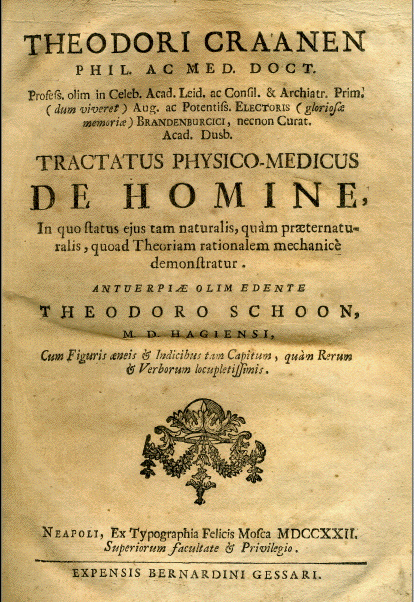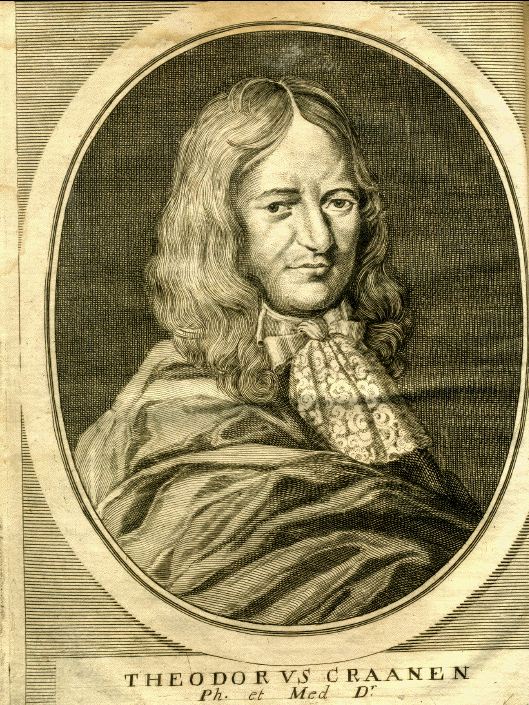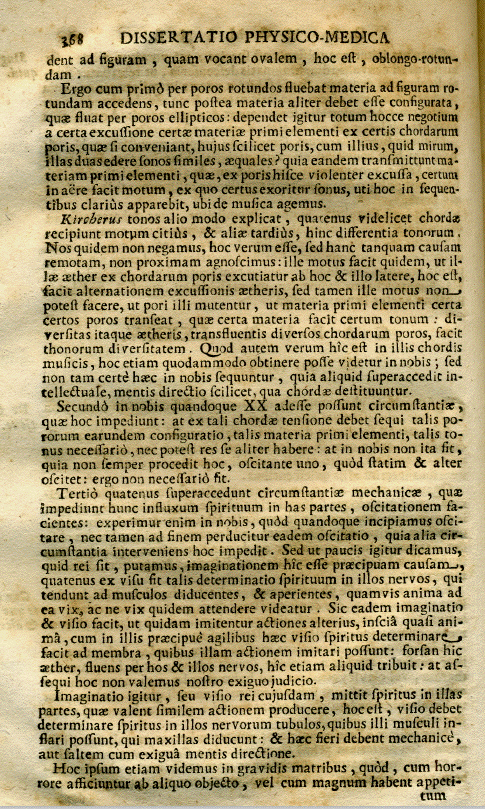- La première édition fut
publiée en 1689. Dans la lignée de
Jacobus Sylvius (Jacques Dubois d'Amiens
1478-1555), Theodorus Craanen fut professeur de
médecine à Leyde (Pays-Bas).
Raisonnant en cartésien, il décrit
dans ce livre la théorie des ferments et
compare le corps à une horloge pour
expliquer ses fonctions.
-
 -
- CRAANEN (Theodorus), of Kranen, was
physician and Doctor of Philosophy and was
appointed in 1655 professor of philosophy at the
(first) university in Nijmegen, from which he in
1670 moved to his appointment as
professor of Philosophy and Mathesis
Universalis at the University of Leiden, and as
administrator of the Staten Collegie in the same
town.
-
- However, his zeal to defend the doctrine of
Descartes and the controversy this caused with
his colleague professor Spanheim gave curators,
in 1673, the chance to dismiss him from both
professorships and to appoint him as professor
of medicine instead.
-
- In this capacity he served the University of
Leiden until the year 1687, when he, at the
invitation of Frederick William, Elector of
Brandenburg, left for Berlin where he was
appointed as first physician. Here he died in
1690 (according to others the 27th March
1688).
-
- His portrait was made by A. Blooteling
(1640-1690) (below). He is the author of many
books on different topics, released separately,
but published completely in Antwerp in 1689. 4o.
Two parts.
-
- The liveliness of his wit and disourse are
praised, but of his knowledge of medicine and
his less thoughtful application of Descartes'
philosophy we receive less favourable testimony,
although this opinion comes from Herman
Boerhaave, whose dislike of Descartes' theory is
well known and which has probably influenced
this negative testimony.
-
- During his stay in Holland he published:
Tractatus Physico-Medicus. of which its 107th
chapter deals with 'De Musica', the 108th 'De
Echo' and 109th 'De Tarantula'. A new edition of
this work appeared in Naples, 1722, 4o.
-
 -
-
- Theodoer von Craanen by Abraham
Blooteling
- Sinebrychoff Art
Museum
- 32.60 cm x 22.70 cm
- copper engraving
-
    -
- Medicine and The Cartesian Image
of Man
- Henk Ten Have
- Theorical Medicine
- 1987;8:235-246
-
- At first Descartes' philosophy exerts a
direct influence on a number of Dutch
physicians, as well as a 17th century current in
medicine, known as the iatrophysical school.
That Dutch medicine temporarily has been
affected by Cartesianism is no coincidence since
Descartes lived in
Holland for twenty years, moving about from
place to place (e.g. Amsterdam, Utrecht,
Leiden). Henricus Regius dit Henry Le Roy
(1598-1679), professor at Utrecht university,
was Descartes' best-known medical follower in
Holland, although later on they are not on the
best of terms about the problem of relation
between body and soul.
-
- In an anonymously published pamphlet
entitled Explicatio mentis humanae (1647),
Regius explains his view that a human being is
an ens per accidens: The soul is not a substance
like the body, but modus corporis: As long as it
is in the body, the soul is anima organica, i.e.
not really distinct from the body. Descartes
answers the "insults" of Regius in his Notae in
Programma (1647) and also in a letter to the
Abbé Picot, the translator of his
Principia Philosophiae. He objected to Regius
that "it is not an accidental feature of the
human body to be joined to a soul, but its very
nature".
-
- One of Regius' pupils is Theodoor Craanen
(1621-1689), who first works as a professor of
logic and metaphysics in Leiden, but is offered
later on, after discords on his Cartesianism
with colleagues and students, the position of
professor of medicine because this is considered
less dangerous. Craanen's contribution to
medicine has been of a theoretical nature; he
neglects instruction at the sick-bed. He is
interested in physical functions and their
mechanical explanation.
-
- In Oeconomia animalis (1685) he develops the
theory that the movement of particles in the
vessels and pores of organs is essential for
health. Posthumously his writing Tractatus
physico-medicus de Homme is published (1689),
the mere title of which strongly makes one think
of Descartes' Treatise of Man, of which, for
that matter, Florentius Schuyl, a predecessor of
Craanen in Leiden, has provided, although
in Latin, the first publication in 1662.
-
- In the first chapter Craanen makes
clear that he prefers to follow the same method
as Descartes. He compares the human body with a
clock, the organs with its wheels and the blood
and animal spirits with the weights. The
harmonious functioning of the organism, the
'oeconomia animalis', is explained from the
corpuscular structure of the body and the
movement of the component particles. Digestion
for instance is explained by the laws of
mechanics: The food eaten falls apart into
numerous tiny parts of different sizes. The
alimentary organs contain pores of different
shapes. Every particle disappears through a
congruent opening and thus reaches the tissue it
is meant for: What is good for bone, is
transported to the bones, what is good for flesh
to the muscles. Disease is caused when particles
block up pores that are too small or have the
wrong shape. Similar conceptions we find with
Blankaart and Bontekoe, pupils of Craanen's who
elaborated a mechanistic pathology.
-
- The importance of Craanen's
conceptions does not lie so much in this
pore-theory (which, for that matter, we also
find in Descartes himself), as in his mechanical
explanation of physical functioning. This way of
explaining things also came into vogue among
physicians that had been less directly
influenced by Descartes. The theory of blood
circulation, described by Harvey in 1628,
enormously benefited the mechanical
interpretation of the body. The conception of
liquid flowing through a closed tube-system was
an incentive to consider the body a 'machina
hydraulica pneumatica' (in Borelli's
words).
-
- There even originated a iatrophysical school
in 17th century medical science, which explained
physical processes in health and illness
exclusively in mechanical or mathematical terms.
The origin of this school is to be found at
Padua university, where under Galilei's
influence the physician Santorio
(1561-1636) worked out the idea that number,
weight and size are of more importance to the
explanation of the functioning of the physical
organism than are Galenic qualities such as
cold-warm and dry-humid. Santorio developed
various instruments to quantify physical
functions, among other things the 'pulsilogium',
a kind of pendulum with which one can measure
the pulse-rate. The same striving for
objectivation of physical functions can be found
with other physicians from Padua, such as
William Harvey, who wrote his dissertation in
1602, and Henricus Regius, who was one of
Santonio's pupils.
-
- It was through this counting and measuring
that Harvey found the proof for the theory that
blood circulates through heart and vessels. The
influence of natural scientific thinking also
reaches two other representatives of
iatrophysics: Alphonso Borelli (1608-1679) and
his pupil Lorenzo Bellini (1643-1704). In 1680
the former presented in De motu animalium a
theory of the mechanics of muscular functioning
with detailed computations of muscular
strength.
-
- Indirectly and in the long run the influence
of Cartesianism on medical science has been much
greater however. Descartes' project of
establishing a framework of positive and true
knowledge has become a model for any endeavour
to acquire scientific knowledge. It has also
become determinative for scientific principles
as such. Further, Descartes' thinking leads to a
fictional way of thinking with respect to the
human body as an automatic machine. Cartesianism
implies an optimistic view on the development of
human knowledge, with the explicit promise of
great progress in the field of medicine. These
three points can be explained as follows.
-
- The first rule of method which Descartes
formulates in the second part of the Discourse
on the Method reads: "Accept nothing as true
which I did not clearly recognize to be so: that
is to say, to avoid carefully precipitation and
prejudice, and to accept nothing in my
judgements beyond what presented itself so
clearly and distinctly to my mind, that I should
have no occasion to doubt it".
-
- Descartes' starting point is a fundamental
distrust of empirical truths, our own body
included, and therefore also of our sensorial
capacity to discover that truth. In a process of
doubt towards methods generally applied
Descartes withdraws to the Ego, the capacity of
thinking itself, as a last autonomous position
set apart from the beliefs of which the Ego has
dissociated itself.
-
- Descartes's basic aim is not to discover
only the truth: He is trying to find the
indubitable truth. In this pursuit of certainty,
the only thing certain and indubitable is the
subject, which, while observing, thinking and
speaking forms a conception of the world
outside. Consequently the world which originally
contains the knowing subject itself has become a
world of objects, an objective reality placed
apart from the subjct and knowledge has become
an activity of the Ego, the first person
singular.
|






